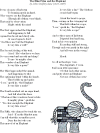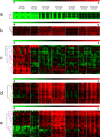Immune prevention of mammary carcinogenesis in HER-2/neu transgenic mice: a microarray scenario
- PMID: 15690207
- PMCID: PMC11034326
- DOI: 10.1007/s00262-004-0635-4
Immune prevention of mammary carcinogenesis in HER-2/neu transgenic mice: a microarray scenario
Abstract
Neoplastic transformation is a multistep process in which gene products of specific regulatory pathways are involved at each stage. Identification of these overexpressed or mutated gene products provides an unprecedented opportunity to address the immune system against defined antigens and eliminate transformed cells. Mice transgenic for these oncogenes (e.g. HER-2/neu, a prototype of deregulated oncogenic protein kinase membrane receptors) are ideal experimental models for assessing the potential of active immunization. The demonstration that vaccines can cure HER-2/neu transplantable tumors, prevent their onset and delay the progression of preneoplastic lesions in mice at risk suggests that efficient immunological inhibition of HER-2/neu carcinogenesis can be achieved by specific vaccination. To further explore this issue, halting of tumor progression in the mammary glands of BALB-neuT mice with two immunization protocols in two laboratories has been studied independently by DNA microarray analysis. Combination of the two sets of results revealed a clear correlation between them when the tumor mass was titrated by transcription profiling. It was also clear that both protocols induced a strong, polyclonal antibody response and halted tumor growth at a condition very similar to that at which the vaccination began. Differences in the expression profiles were mainly related to the expression levels of a few chemokines and T-cell-specific genes that may be in some way correlated with the efficacy of the vaccination. Last, combination of the expression data with the protection results indicated that chronic vaccination is needed to maintain an active IFN-gamma-mediated response in the mammary gland.
Figures







Similar articles
-
Immunoprevention of HER-2/neu transgenic mammary carcinoma through an interleukin 12-engineered allogeneic cell vaccine.Cancer Res. 2004 Jun 1;64(11):4001-9. doi: 10.1158/0008-5472.CAN-03-2984. Cancer Res. 2004. PMID: 15173014
-
Combined allogeneic tumor cell vaccination and systemic interleukin 12 prevents mammary carcinogenesis in HER-2/neu transgenic mice.J Exp Med. 2001 Nov 5;194(9):1195-205. doi: 10.1084/jem.194.9.1195. J Exp Med. 2001. PMID: 11696586 Free PMC article.
-
Inhibition of mammary carcinoma development in HER-2/neu transgenic mice through induction of autoimmunity by xenogeneic DNA vaccination.Cancer Res. 2005 Feb 1;65(3):1071-8. Cancer Res. 2005. PMID: 15705909
-
ErbB2 transgenic mice: a tool for investigation of the immune prevention and treatment of mammary carcinomas.Curr Protoc Immunol. 2008 Aug;Chapter 20:Unit 20.9.1-20.9-10. doi: 10.1002/0471142735.im2009s82. Curr Protoc Immunol. 2008. PMID: 18729063 Review.
-
Immunological inhibition of carcinogenesis.Cancer Immunol Immunother. 2004 Mar;53(3):204-16. doi: 10.1007/s00262-003-0483-7. Epub 2004 Jan 13. Cancer Immunol Immunother. 2004. PMID: 14722672 Free PMC article. Review.
Cited by
-
Inflammation and breast cancer. Inflammatory component of mammary carcinogenesis in ErbB2 transgenic mice.Breast Cancer Res. 2007;9(4):211. doi: 10.1186/bcr1745. Breast Cancer Res. 2007. PMID: 17705881 Free PMC article. Review.
-
An integrated approach of immunogenomics and bioinformatics to identify new Tumor Associated Antigens (TAA) for mammary cancer immunological prevention.BMC Bioinformatics. 2005 Dec 1;6 Suppl 4(Suppl 4):S7. doi: 10.1186/1471-2105-6-S4-S7. BMC Bioinformatics. 2005. PMID: 16351756 Free PMC article.
References
-
- Backstein K. The blind men and the elephant. New York: Scholastic; 1992.
-
- Boggio K, Nicoletti G, Di Carlo E, Cavallo F, Landuzzi L, Melani C, Giovarelli M, Rossi I, Nanni P, De Giovanni C, Bouchard P, Wolf S, Modesti A, Musiani P, Lollini PL, Colombo MP, Forni G. Interleukin-12 mediated prevention of spontaneous mammary adenocarcinomas in two lines of Her-2/neu transgenic mice. J Exp Med. 1998;188:589. - PMC - PubMed
-
- Calogero RA, Musiani P, Forni G, Cavallo F. Toward a long-lasting immune prevention of HER2 mammary carcinomas: directions from transgenic mice. Cell Cycle. 2004;3:704–706. - PubMed
-
- Cappello P, Triebel F, Iezzi M, Caorsi C, Quaglino E, Nanni P, Amici A, Di Carlo E, Musiani P, Giovarelli M, Forni G. LAG-3 enables DNA vaccination to persistently prevent mammary carcinogenesis in HER-2/neu transgenic BALB/c mice. Cancer Res. 2003;63:2518–2525. - PubMed
Publication types
MeSH terms
Substances
LinkOut - more resources
Full Text Sources
Molecular Biology Databases
Research Materials
Miscellaneous

